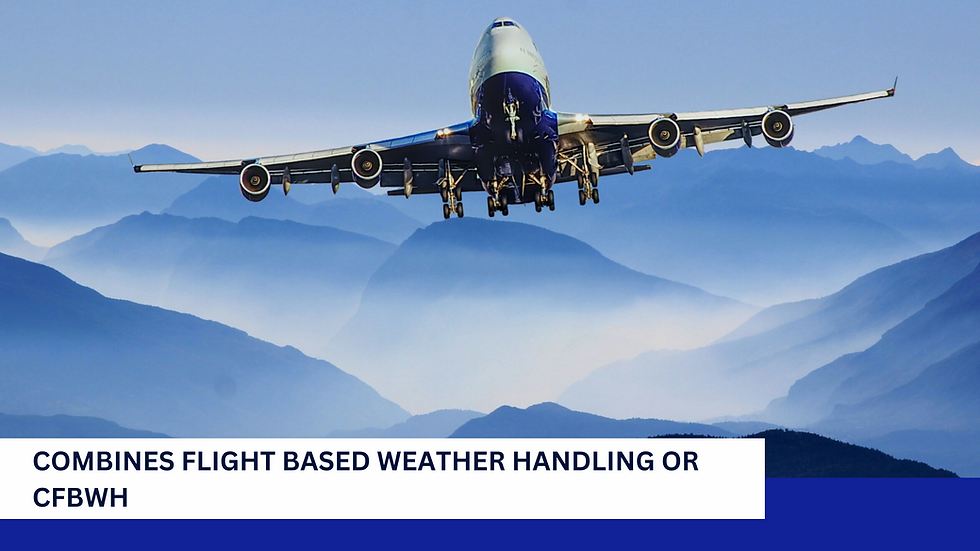Combines Flight-Based Weather Handling: Revolutionizing Aviation
- passyourcert24
- Jan 22
- 3 min read
Aviation has always been a frontier of innovation, striving to improve safety, efficiency, and reliability. One of the most transformative advancements in recent years is the introduction of Combines Flight-Based Weather Handling (CFBWH). This groundbreaking technology is reshaping how aviation professionals manage weather-related challenges, ensuring safer and more efficient flights.
Weather has historically been a significant factor in aviation delays, accidents, and operational inefficiencies. From turbulence to storms, pilots and air traffic controllers face various unpredictable scenarios. CFBWH addresses these challenges head-on by integrating advanced technology with real-time data, enabling aviation stakeholders to make informed decisions. This blog delves into how CFBWH works, its benefits, and its potential impact on the future of aviation.
What is Combines Flight-Based Weather Handling (CFBWH)?
CFBWH is a sophisticated system that leverages real-time meteorological data, predictive analytics, and AI-driven insights to optimize flight operations in varying weather conditions. Unlike traditional systems, which rely heavily on static weather forecasts, CFBWH combines:
Real-Time Weather Monitoring: Accessing live data from satellites, ground stations, and onboard sensors.
Predictive Analytics: Utilizing machine learning algorithms to forecast weather patterns and their potential impact on specific flight paths.
Dynamic Flight Adjustments: Providing pilots and controllers with actionable recommendations for route adjustments, altitude changes, and speed modifications.
By seamlessly integrating these components, CFBWH ensures that weather-related disruptions are minimized, enhancing both safety and operational efficiency.
Key Features of CFBWH
Enhanced Weather Forecast Accuracy
CFBWH systems use high-resolution models and AI to provide hyper-localized weather forecasts. This precision allows pilots to anticipate and prepare for micro-weather events, such as wind shear or localized turbulence.
Automated Route Optimization
With real-time data, CFBWH can suggest optimal flight paths that avoid adverse weather, reducing fuel consumption and delays.
Seamless Integration with Existing Systems
CFBWH is designed to work alongside existing aviation technologies, such as Traffic Collision Avoidance Systems (TCAS) and onboard navigation tools.
Pilot and Crew Support
By offering clear, actionable insights, CFBWH reduces the cognitive load on pilots and enhances decision-making during critical moments.
Benefits of CFBWH
The adoption of Combines Flight-Based Weather Handling offers numerous advantages, including:
Increased Safety: With better weather prediction and proactive measures, the likelihood of weather-related accidents is significantly reduced.
Operational Efficiency: Airlines can save time and fuel by avoiding unnecessary diversions or delays caused by unanticipated weather conditions.
Reduced Environmental Impact: Optimized routes mean lower fuel consumption and reduced greenhouse gas emissions.
Improved Passenger Experience: Minimizing delays and turbulence ensures a smoother, more reliable travel experience for passengers.
Applications in Modern Aviation
CFBWH is already making waves across various segments of the aviation industry:
Commercial Aviation: Airlines are leveraging CFBWH to enhance punctuality and reduce operational costs.
Military Operations: Armed forces use CFBWH to improve mission planning and execution in challenging weather conditions.
Private Aviation: Private jet operators and charter companies are adopting CFBWH to offer safer, more personalized services to their clients.
Unmanned Aerial Vehicles (UAVs): Drones and other UAVs benefit significantly from CFBWH, especially for operations in areas with unpredictable weather.
Challenges and Future Outlook
While CFBWH offers immense potential, its widespread adoption faces certain challenges:
High Implementation Costs: Developing and integrating CFBWH systems can be expensive, particularly for smaller operators.
Data Privacy Concerns: The use of real-time data from multiple sources raises questions about data security and ownership.
Training Requirements: Pilots, controllers, and other stakeholders must be trained to utilize CFBWH effectively.
Despite these hurdles, the future of CFBWH looks promising. With ongoing advancements in AI, data analytics, and aviation technology, CFBWH is poised to become a standard feature in global aviation operations.
Conclusion
Combines Flight-Based Weather Handling (CFBWH) represents a significant leap forward in aviation technology. By harnessing the power of real-time data and advanced analytics, CFBWH not only enhances flight safety but also improves operational efficiency and environmental sustainability. As the aviation industry continues to evolve, adopting innovative solutions like CFBWH will be crucial to overcoming future challenges.
Whether you’re an aviation professional or an enthusiast, understanding the impact of technologies like CFBWH offers valuable insights into the future of flight. With its ability to mitigate weather-related risks and optimize performance, CFBWH is truly revolutionizing the skies.







Comments